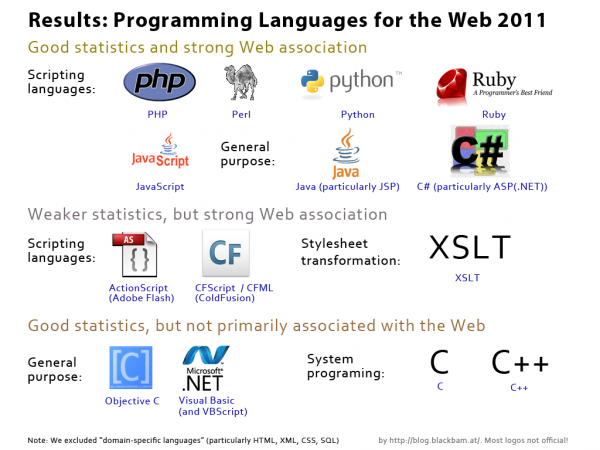Recently I finished my second bachelor thesis called “Programming Languages for the Web 2011” with the aim of digging deeper into programming language design, structure, usage statistics and affordances of the WWW. It was a matter of interest to know what possibilities web developers have and what programming language they prefer to use.
- Have you ever asked if there are still good alternatives to PHP and Java?
- Are you sick of reading endless discussions about which programming languages are better, without substantial evidence?
- Are you searching for a scientific approach to compare and understand the differences between programming languages to make an important choice?
If any of these points is of interrest for you, then you can download and read the whole work from here, as it might be useful.
> Download and read the whole work <
Abstract
This work shows the differences between and the varieties of programming languages for the World Wide Web at present times and also helps understanding these. To reach this aim, the differences between programming languages are analyzed, and the affordances and circumstances of programming for the WWW are determined as well. Furthermore, an analysis of usage statistics is made to show what certain programming languages are in use today.
As a result the most important programming languages for the Web 2011 are determined. Furthermore, a detailed programming language comparison sheet is presented, which can be used to compare the suitability of common and uncommon programming languages for Web use in general.
Results
Programming languages have huge differences among themselves. They can be classified among their computational model, hardware abstraction level and programming paradigms. Technically comparable distinctive features are basically the level of compilation/interpretation, storage management, type system, effectiveness and expressiveness. Other distinctive features include popularity and a lot of things associated with popularity, syntactic / semantic rules (which are only difficult to compare technically) and the intended use of a programming language.
Affordances for programming languages on the Web are different and limited. There has to be a distinction between server-side programming, client-side programming and web application programming:
- Server-side programming can be done with every programming language basically (usually using CGI), while specific “Module-/ Plugin-loading mechanisms” or special software solutions usually provide significant advantages.
- Client-side programming is limited to the capacity of important Web browsers, so the JavaScript and XSLT-standards as Java Applets are kind of outstanding here, as all other technologies must usually use browser Plugins.
- Web Application Programming can be done with every programming language to be compiled for the client system (but there are advantages/disadvantages to consider)
Especially web specific features, frameworks, solutions, techniques and technologies can improve a programming languages‟ qualification for the Web significantly.
As a result of the work we can assume, that programming languages for the Web 2011 are mostly scripting languages that have a tendency to high hardware abstraction. Based on their popularity, we figured out the following candidates to be the most important ones currently, according to statistics (note that the information in brackets only describes primary characteristics):
- Java (general purpose language, especially the applications of Java dedicated to Web programming, server-side / client-side)
- C# (general purpose language, especially the applications of C# dedicated to Web programming, server-side, proprietary)
- PHP (scripting language, server-side)
- Perl (scripting language, server-side)
- Python (partly scripting language, server-side)
- Ruby (scripting language, server-side)
- JavaScript (scripting language, client-side)
It stands out that C# is the only “mostly proprietary” language to be widely used for web programming purposes and that 5 out of 7 candidates are scripting languages.
There are some more programming languages, which are almost equally important, but have one of “not as good in statistics” or “primarily not intended for web programming”, these are:
- CFML/CFScript for ColdFusion (scripting language, server-side, proprietary)
- ActionScript (scripting language, clident-side, proprietary)
- XSLT (transformation programming language, client-side)
- Objective-C (application programming language, client-side)
- C (system programming language, client-side / server-side)
- C++ (system programming language, client-side / server-side)
- Visual Basic (with descendant VBScript, client-side / server-side, proprietary)
There are a lot of domain specific languages which are not included in this comparison as they are no real programming languages; these are HTML, XML, CSS, and SQL in the first place.




No comments yet
Kommentare abonnieren (RSS) or URL Trackback
Leave a comment: